1.4 government intervention
1/49
There's no tags or description
Looks like no tags are added yet.
Name | Mastery | Learn | Test | Matching | Spaced |
|---|
No study sessions yet.
50 Terms
merit goods
demerit goods
positive externality
negative externality
define minimum price and why it may be introduced in a market
A minimum price is a price set by government, below which the price is not allowed to fall
To be effective the minimum price needs to be set above the free market equilibrium price
Examples include minimum wage laws or price floors for agricultural products.
outline the details of minimum price on alcohol which is in place in the uk
minimum price - 50p per unit of alcohol
this policy aims to reduce alcohol related harm such as crime,liver failure,NHS waiting lists it targets cheap and accessible alcohol
Supply and demand impact of a minimum price
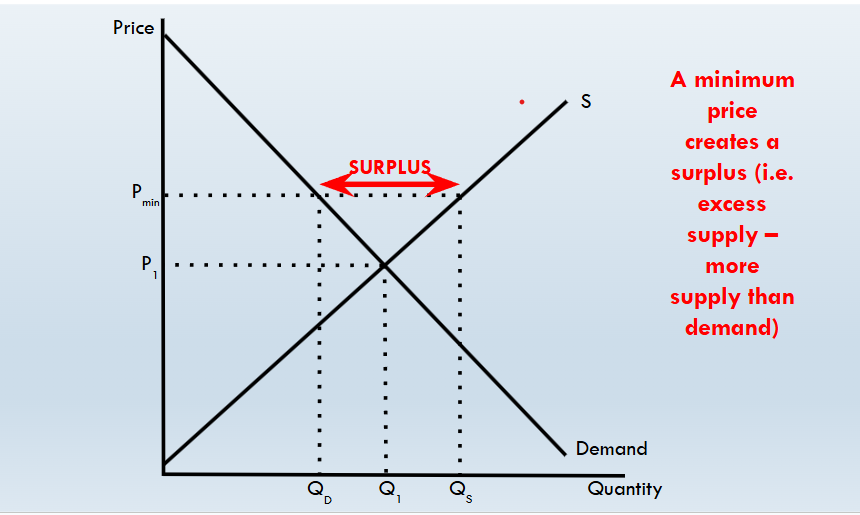
minimum price purpose
Generally used to raise the price of a good that creates a negative externality
The increase in price should push it nearer to reflecting the social costs – i.e. the total costs to society
protecting producers (farmers) and minimum wage
minimum price problems
4
A minimum price creates a surplus and disequilibrium will need to be maintained
Some producers would be happy to sell below the minimum price
Potential for a black market
Poorer households are likely to be disproportionately affected
Government may set price too low (e.g. alcohol minimum price in England and Wales) so that it has little or no impact
maximum price
A maximum price is a price set by government, above which the price is not allowed to rise
To be effective the maximum price needs to be set below the free market equilibrium price
why may maximum prices be introduced
Could be used to lower the price of a good that creates a positive externality
The reduction in price should price consumers in to the market and increase the consumption
A price cap could also be used to make necessities affordable (food, housing) or to prevent exploitation of consumers by powerful businesses
maximum prices examples
Maximum price: car £54.85; motorbike £29.65
Many garages offer MOTs significantly below the maximum price
Train tickets
Some fare types are regulated by government
Train companies prevented from raising price too high
Both have a positive externality element to them:
MOTs check a car is road-safe
Train use reduces congestion and emissions compared to car use
maximum prices diagram
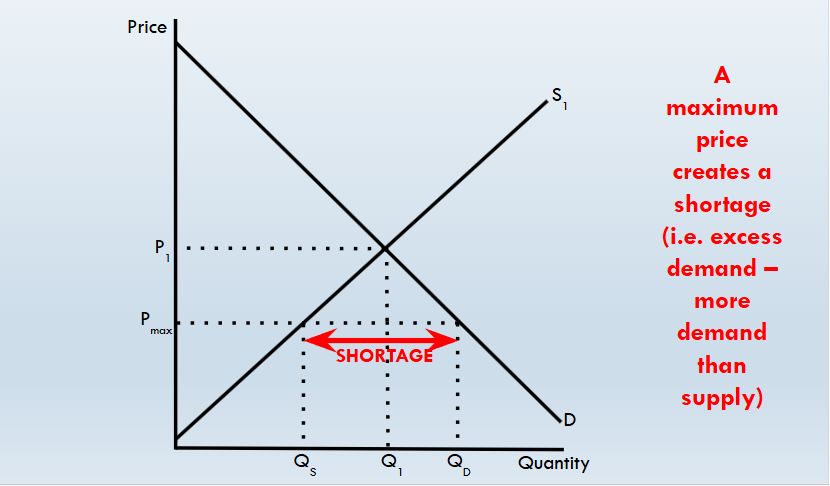
problems by maximum price
3
A maximum price will create a shortage and disequilibrium will need to be maintained
Some consumers may be prepared to pay above the maximum price to get the goods that they want
Potential for a black market
maximum prices impact on producer surplus
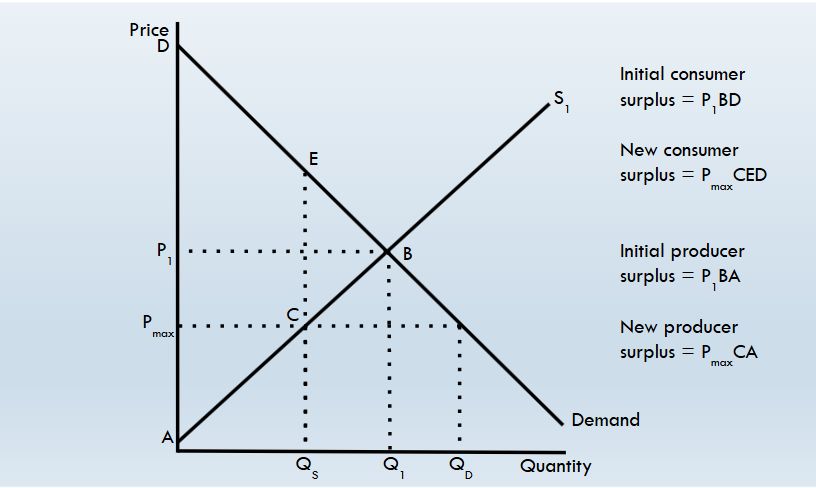
maximum prices consumer surplus
Consumer surplus
Consumer surplus increases as the price falls
However
As there is a shortage some consumers will not be able to consume the good and so will miss out (i.e. Q1 falls to QS)
taxation of carbon emissions
Taxation of carbon emissions is a viable alternative
Each unit of production that creates pollution is taxed, or each actual ton of carbon emitted is taxed
It raises the price of the polluting activity
Ideally the tax should be equal to the external cost - this would increase the MPC to the value of the MSC
“Internalising the externality”
pollution permits VS taxation
Permits create a stronger financial incentive to cut pollution than taxes
There is a clearer limit on pollution with pollution permits than with taxation
The total number of permits is the limit
Harder to predict the impact on emissions when imposing a tax
public good
avaliable to everyone and one persons use does not reduce its avaliability to others
-clean air
non-rival
one persons use does not reduce its avaliability to others
non excludable
no one can be prevented from using the good ,everyone can access
why are public goods provided by the state
as private companies typically do not have enough incentive to provide them they are non rival. businesses are unable to profit from them so the state steps in to ensure these goods are available for everyone to use ensuring society’s well-being
advantages and disadvantages of the state providing
unviersal access
equity
high tax
misallocation of resources
unintended consequences
Policy interventions may lead to effects that are unanticipated
Individuals in society can be unpredictable and may respond to policies in a way that is unexpected
These unintended consequences could be either positive or negative
Examples:
Smoking ban – increased use of outdoor patio heaters, leading to greater electricity consumption
5p plastic bag charge – increased theft of baskets
carbon tax evaluation
regressive impact: It can disproportionately affect low-income households, who spend more of their income on energy.
Industry resistance: Some industries may oppose it, especially if they rely heavily on fossil fuels.
Competitiveness: It might make domestic products more expensive than imports from countries without a carbon tax—unless border adjustments are applied.
contractionary fiscal policy
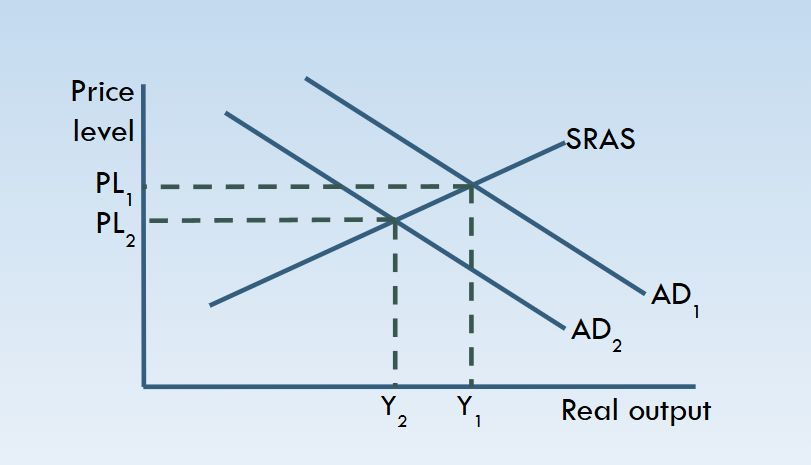
distortion of price signals leading to government failure
Some government policies distort the prices that would otherwise be created by the market (e.g. taxes, subsidies, min/max pricing)
Example:
Minimum wage – raises income levels but may mean businesses lay off the lowest paid which were the people the government had wanted to protect
government failure administrative costs
Sometimes the bureaucracy involved in administering a policy may become very ‘bloated’ and costly
If the costs of administering a policy are greater than the benefits to society of that policy then there is likely to be a misallocation of resources
information gaps market failure
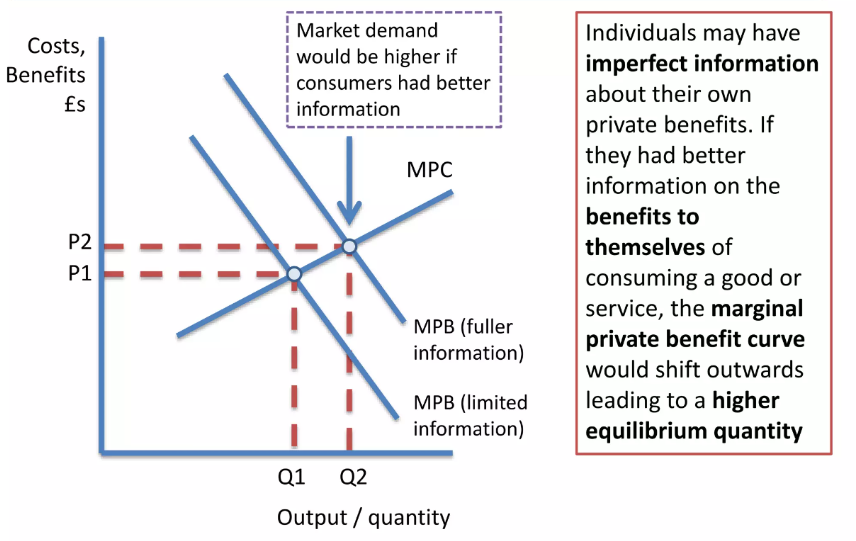
indirect taxes
Used to reduce production/consumption of negative externalities.
Examples: Cigarettes (tobacco duty), petrol, alcohol, sugar tax.
Diagram: Supply shifts left (or upward if specific tax).
Evaluation:
Tax revenue generation (used for hypothecation?)
Unintended consequences (e.g., black markets)
Elasticity impacts effectiveness
Equity: regressive impact on lower-income households
subsidies
Used to increase production/consumption to internalise positive externalities.
Examples: Public transport subsidies, renewable energy support.
Diagram: Supply shifts right (or downward).
Evaluation:
Opportunity cost to government
Risk of government failure (misallocation)
Dependency of firms
Elasticity and effectiveness
state provision of merit goods
Example: NHS, education
Address under-consumption due to information failure
Evaluation:
Government failure risk
Overuse or inefficiency
Equity vs. efficiency again
Tradable Pollution Permits (Link with Theme 4 for synoptic depth)
Market-based approach to internalising external costs.
Firms buy/sell pollution rights.
Evaluation:
Hard to set correct cap
Admin costs
Risk of monopolisation of permits
real world examples
7
Sugar Tax (UK) – indirect tax on soft drinks (2018)
Plastic Bag Charge – reduction in plastic bag usage
Minimum Alcohol Pricing – Scotland (2018)
Congestion Charge (London) – externalities and road pricing
Subsidies for Electric Cars/Green Energy
COVID vaccine funding – state provision, public good
Ofgem / Ofcom – regulators enforcing rules on utilities
evaluations for indirect taxation
4
Time lags – effects take time to work,it might take time for consumers to change their behavior (due to addiction, habit, or lack of substitutes).
- Higher prices for consumers;
- May force firms out of business leading to negative costs for the whole economy;
- Inelastic goods will not see consumption fall;
- Development of illegal markets;
- Regressive taxation
indirect taxes
An indirect tax is a tax imposed on goods or services, which is paid by producers to the government but is often passed on to consumers through higher prices.
why may government intervene in markerts
To correct market failure (e.g. externalities, missing markets)
To promote equity or redistribute income
To regulate monopolies
how can information provision correct market failure
Market failure can occur due to information gaps. The government can provide accurate information (e.g. health warnings on cigarettes), allowing consumers to make more informed choices, thus improving allocative efficiency.
subsidies effectiveness
Benefits:
Reduces price, increases consumption of merit goods
Internalises positive externalities
Supports producers and innovation (e.g. renewables)
Drawbacks:
Cost to government (opportunity cost)
May cause overproduction or dependency
Difficult to set correct amount
cost to taxpayer
advantages on maximum price in housing market
Advantages:
Increases affordability for low-income households
Prevents exploitation during housing crises
May reduce homelessness
Disadvantages:
Creates excess demand (shortages)
Disincentivises landlords from maintaining or supplying housing
May lead to black markets or waiting lists
why would there be underconsumption of education in the free market
People would be unable to afford it and may think that it is not worth it due to the opportunity cost of getting a job
what is government intervention
Government intervention is where the government steps in to correct market failure and improve the allocation of resources
why is supply of public good inelastic
because supply does not vary depending on price and profit
why are taxes ineffective when trying to counter inelastic demand
Because the consumers will continue to consume the goods even if the consumer burden is as large as it can be.
indirect taxes diagram

why are indirect taxes seen as regressive
because even when people have a high income they pay the same tax as those who have a low income
why are merit goods underprovided
they have a higher private cost than social cost so these externalities are ignored and the good is underproduced
internalise the externality
an attempt to deal with an externality by bringing an external cost or benefit into the price system through tax
what would cause the demand for houses to increase
Limited supply, would be difficult to increase the supply of houses due to time lags
- buying of second homes by the wealthy
- migrants buying homes
what are tradeable pollution permits
Companies are offered permits as rewards for not polluting and they can trade this permit to other firms for money.
what are bad about pollution permits
A lot of companies have found legal loopholes around this and can exploit the system for more profit whilst still polluting
- It is not global so they can easily relocate to bypass the permits entirely
- Big firms / monopolies with deep pockets can afford the permits and continue to pollute
what is bad about pollution permits
- The firms can use the money from these permits to reinvest and further grow their business and shift output outwards
- government may take a % or tax the permits and can then increase rev and spending
- Firms can maintain their competitiveness and profitability
information gaps - government
government may not have all the right information and this may lead to a further misallocation of resources
(this explains why some subsidies may be exacted incorrectly or the government intervenes poorly)